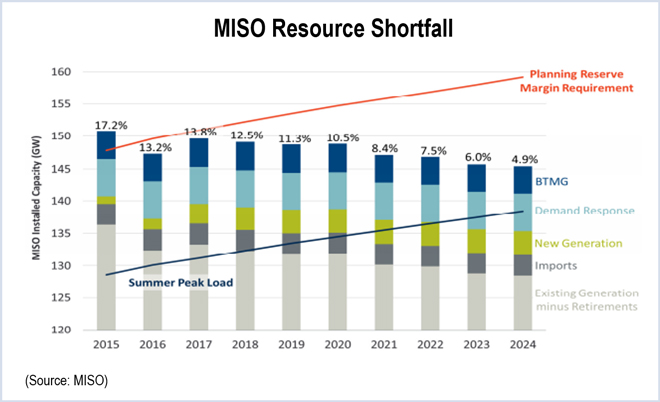By Chris O’Malley

There’s some urgency: MISO forecasts that its Planning Reserve Margin Requirement, which is peak demand plus the planning reserve margin, could drop below its target as early as 2016.
The RTO last month released a draft white paper, “Issues Statement on Facilitating Resource Adequacy in the MISO Region,” to serve as a framework for reversing its declining margins.
“Basically, we’re going to have smaller reserve margins and we’re going to have different resources in play,” Joseph Gardner, MISO’s vice president of forward markets and operations services, told stakeholders. “We’re trying to have a common understanding [of] what the issues are.”
The white paper notes that MISO’s current processes do not:
- Ensure transparency across all seasons and all time horizons;
- Address issues related to resource performance, such as fuel assurance and winterization;
- Treat a resource consistently as it moves from interconnection to retirement; or
- Provide applicable incentives for all load-serving entities to ensure adequate resources.
Technically, of course, MISO is not the guarantor of resource adequacy. LSEs and states that regulate them are responsible for assuring adequate resources in their jurisdictions.
MISO is building its efforts to support LSEs and the states around four “strategic goals.”
Better Picture Needed
One goal is “Regional Assessment and Transparency,” based on the survey of LSEs that MISO conducted last year with the Organization of MISO States (OMS). Some stakeholders said OMS needs to improve the survey.
Jeff Beattie, a senior engineer at Consumers Energy, said there’s skepticism about the reliability of the data collected, noting that the OMS survey is not subject to peer review. “How can we get further buy-in?” he asked.
“The nature of the OMS survey has been such that confidentiality is strongly protected and only zonal-level shortfalls have been provided to stakeholders. That greatly limits the value of the survey results,” Consumers said in pre-filed comments ahead of Thursday’s workshop.
Consumers suggests that MISO follow the example of NYISO’s “Gold Book,” which provides details for new generators and proposed and actual unit suspensions and retirements.
“If MISO moved in this direction on transparency, it would be much easier for all parties to accurately evaluate resource adequacy in the MISO footprint,” Consumers said.
MISO traditionally has forecast demand based on individual forecasts performed by LSEs, transmission operators and others. However, it recently hired a consulting firm to conduct independent load forecasts through 2017.
“As reserve margins decline, it is now more critical than ever to have confidence that demand forecasting is consistent and accurate,” the paper says.
Looking Outward
Another of the four goals is “Industry Influence, Monitoring and Coordination,” which deals with issues partly or entirely outside of MISO’s direct control, such as fuel reliability, electric and natural gas coordination and support from neighboring systems.
For example, MISO noted that it has been surveying asset owners as to their confidence about fuel deliveries and inventories. The survey is voluntary, however.
As for support from neighboring systems, Entergy has already weighed in by saying that assuming neighboring systems will provide support toward MISO resource adequacy isn’t sufficient.
“If this is an assumption MISO is relying on for [resource adequacy], a study with neighboring systems to determine the appropriate level of support to assume and contractual agreements may be needed to be put in place,” Sarah McCurdy, an analyst with Entergy, said in pre-filed comments.
Other Topics for Debate
Another goal, titled “Evolving the Resource Adequacy Requirements,” deals with MISO’s resource adequacy construct and issues such as retail choice and seasonal and locational considerations.
Traditionally, the focus has been on meeting the summer peak. But one of the questions raised by MISO staff is whether non-summer risk will increase as capacity is squeezed in the years ahead.
“How much of our footprint is winter-peaking?” wondered Amy Jo Miller, commercial market affairs executive at Ameren.
For example, MISO’s paper contemplates that as reserve margins decline, it may have to dispatch seldom-used capacity. This could include increased use of load-modifying resources — such as factories that can reduce energy use by adjusting production schedules and commercial buildings that can reduce air conditioning.
MISO said it has not called on those resources since 2006.
“Because declared emergency conditions will likely become more prevalent as reserve margins decline, MISO may call on LMRs more extensively going forward,” MISO says.
The final goal is “Process Alignment,” which involves identifying and eliminating barriers or inconsistencies within MISO procedures.
One such issue raised by stakeholders is that the current annual construct doesn’t address mid-year retirements and suspensions of generating plants.
Next Meeting
The next workshop meeting is tentatively scheduled for May 15.


